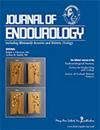求助PDF
{"title":"脉冲铥:YAG 激光、钬:YAG 激光和铥光纤激光的体外比较。","authors":"Marie Chicaud, Stessy Kutchukian, Laurent Berthe, Mariela Corrales, Catalina Solano, Luigi Candela, Steeve Doizi, Daron Smith, Olivier Traxer, Frédéric Panthier","doi":"10.1089/end.2024.0424","DOIUrl":null,"url":null,"abstract":"<p><p><b><i>Objective:</i></b> To characterize the pulse characteristics and risk of fiber fracture (ROF) of the pulsed-Thulium:YAG (p-Tm:YAG) laser and to compare its ablation volumes (AVs) against Holmium:Yttrium-Aluminium-Garnet (Ho:YAG) laser and Thulium fiber laser (TFL). <b><i>Materials and Methods:</i></b> p-Tm:YAG (100 W-Thulio, Dornier-Medtech<sup>©</sup>, Germany) was characterized using single-use 272 μm core-diameter-fibers. p-Tm:YAG characterization included pulse shape, duration, and peak power (PP) studies. ROF was assessed after 5 minutes of continuous laser activation (CLA) at five decreasing fiber bend radii (1, 0.9, 0.75, 0.6, and 0.45 cm). p-Tm:YAG, Ho:YAG (120 W-Cyber-Ho, Quanta<sup>®</sup>, USA), and TFL (60 W-TFLDrive, Coloplast<sup>®</sup>, Denmark) AVs were compared using a 20-mm linear CLA at 2 mm/second velocity in contact with 20 mm<sup>3</sup> hard stone phantoms (HSP) and soft stone phantoms (SSP) (15:3 and 15:5 water to powder ratio, respectively) fully submerged in saline at 0.5 J-20 Hz or 1 J-10 Hz. After CLA, phantoms underwent three-dimensional (3D) micro-scanning (CT) and subsequent 3D segmentation to estimate the AVs, using 3DSlicer<sup>©</sup>. Each experiment was performed in triplicate. <b><i>Results:</i></b> p-Tm:YAG presents a uniform pulse profile in all of the available preset modes. PP ranged from 564 to 2199 W depending on pulse mode. No laser fiber fracture occurred at any bend radius. p-Tm:YAG achieved similar mean AVs to TFL and Ho:YAG for HSP (8.96 ± 3.1 <i>vs</i> 9.78 ± 1.1 <i>vs</i> 8.8 ± 2.8 mm<sup>3</sup>, <i>p</i> = 0.67) but TFL was associated with higher AVs compared with p-Tm:YAG and Ho:YAG (12.86 ± 1.85 <i>vs</i> 10.12 ± 1.89 <i>vs</i> 7.56 ± 2.21 mm<sup>3</sup>, <i>p</i> = 0.002) against SSP. AVs for HSP increased with pulse energy for p-Tm:YAG and Ho:YAG and (11.56 ± 1.8 <i>vs</i> 6.36 ± 0.84 mm<sup>3</sup> and 11.27 ± 1.98 <i>vs</i> 6.34 ± 0.55 mm<sup>3</sup>, <i>p</i> = 0.03 and <i>p</i> = 0.02), whereas AVs for SSP were similar across laser settings for all laser sources. AVs with TFL were similar across laser settings for both phantom types. <b><i>Conclusion:</i></b> p-Tm:YAG combines intermediate PP between Ho:YAG and TFL, a uniform pulse profile, no ROF with increasing deflection and effective ablation rates. Further clinical studies are needed to confirm these <i>in vitro</i> results.</p>","PeriodicalId":15723,"journal":{"name":"Journal of endourology","volume":null,"pages":null},"PeriodicalIF":2.9000,"publicationDate":"2024-10-01","publicationTypes":"Journal Article","fieldsOfStudy":null,"isOpenAccess":false,"openAccessPdf":"","citationCount":"0","resultStr":"{\"title\":\"<i>In Vitro</i> Comparison of Pulsed-Thulium:YAG, Holmium:YAG, and Thulium Fiber Laser.\",\"authors\":\"Marie Chicaud, Stessy Kutchukian, Laurent Berthe, Mariela Corrales, Catalina Solano, Luigi Candela, Steeve Doizi, Daron Smith, Olivier Traxer, Frédéric Panthier\",\"doi\":\"10.1089/end.2024.0424\",\"DOIUrl\":null,\"url\":null,\"abstract\":\"<p><p><b><i>Objective:</i></b> To characterize the pulse characteristics and risk of fiber fracture (ROF) of the pulsed-Thulium:YAG (p-Tm:YAG) laser and to compare its ablation volumes (AVs) against Holmium:Yttrium-Aluminium-Garnet (Ho:YAG) laser and Thulium fiber laser (TFL). <b><i>Materials and Methods:</i></b> p-Tm:YAG (100 W-Thulio, Dornier-Medtech<sup>©</sup>, Germany) was characterized using single-use 272 μm core-diameter-fibers. p-Tm:YAG characterization included pulse shape, duration, and peak power (PP) studies. ROF was assessed after 5 minutes of continuous laser activation (CLA) at five decreasing fiber bend radii (1, 0.9, 0.75, 0.6, and 0.45 cm). p-Tm:YAG, Ho:YAG (120 W-Cyber-Ho, Quanta<sup>®</sup>, USA), and TFL (60 W-TFLDrive, Coloplast<sup>®</sup>, Denmark) AVs were compared using a 20-mm linear CLA at 2 mm/second velocity in contact with 20 mm<sup>3</sup> hard stone phantoms (HSP) and soft stone phantoms (SSP) (15:3 and 15:5 water to powder ratio, respectively) fully submerged in saline at 0.5 J-20 Hz or 1 J-10 Hz. After CLA, phantoms underwent three-dimensional (3D) micro-scanning (CT) and subsequent 3D segmentation to estimate the AVs, using 3DSlicer<sup>©</sup>. Each experiment was performed in triplicate. <b><i>Results:</i></b> p-Tm:YAG presents a uniform pulse profile in all of the available preset modes. PP ranged from 564 to 2199 W depending on pulse mode. No laser fiber fracture occurred at any bend radius. p-Tm:YAG achieved similar mean AVs to TFL and Ho:YAG for HSP (8.96 ± 3.1 <i>vs</i> 9.78 ± 1.1 <i>vs</i> 8.8 ± 2.8 mm<sup>3</sup>, <i>p</i> = 0.67) but TFL was associated with higher AVs compared with p-Tm:YAG and Ho:YAG (12.86 ± 1.85 <i>vs</i> 10.12 ± 1.89 <i>vs</i> 7.56 ± 2.21 mm<sup>3</sup>, <i>p</i> = 0.002) against SSP. AVs for HSP increased with pulse energy for p-Tm:YAG and Ho:YAG and (11.56 ± 1.8 <i>vs</i> 6.36 ± 0.84 mm<sup>3</sup> and 11.27 ± 1.98 <i>vs</i> 6.34 ± 0.55 mm<sup>3</sup>, <i>p</i> = 0.03 and <i>p</i> = 0.02), whereas AVs for SSP were similar across laser settings for all laser sources. AVs with TFL were similar across laser settings for both phantom types. <b><i>Conclusion:</i></b> p-Tm:YAG combines intermediate PP between Ho:YAG and TFL, a uniform pulse profile, no ROF with increasing deflection and effective ablation rates. Further clinical studies are needed to confirm these <i>in vitro</i> results.</p>\",\"PeriodicalId\":15723,\"journal\":{\"name\":\"Journal of endourology\",\"volume\":null,\"pages\":null},\"PeriodicalIF\":2.9000,\"publicationDate\":\"2024-10-01\",\"publicationTypes\":\"Journal Article\",\"fieldsOfStudy\":null,\"isOpenAccess\":false,\"openAccessPdf\":\"\",\"citationCount\":\"0\",\"resultStr\":null,\"platform\":\"Semanticscholar\",\"paperid\":null,\"PeriodicalName\":\"Journal of endourology\",\"FirstCategoryId\":\"3\",\"ListUrlMain\":\"https://doi.org/10.1089/end.2024.0424\",\"RegionNum\":2,\"RegionCategory\":\"医学\",\"ArticlePicture\":[],\"TitleCN\":null,\"AbstractTextCN\":null,\"PMCID\":null,\"EPubDate\":\"\",\"PubModel\":\"\",\"JCR\":\"Q1\",\"JCRName\":\"UROLOGY & NEPHROLOGY\",\"Score\":null,\"Total\":0}","platform":"Semanticscholar","paperid":null,"PeriodicalName":"Journal of endourology","FirstCategoryId":"3","ListUrlMain":"https://doi.org/10.1089/end.2024.0424","RegionNum":2,"RegionCategory":"医学","ArticlePicture":[],"TitleCN":null,"AbstractTextCN":null,"PMCID":null,"EPubDate":"","PubModel":"","JCR":"Q1","JCRName":"UROLOGY & NEPHROLOGY","Score":null,"Total":0}
引用次数: 0
引用
批量引用


